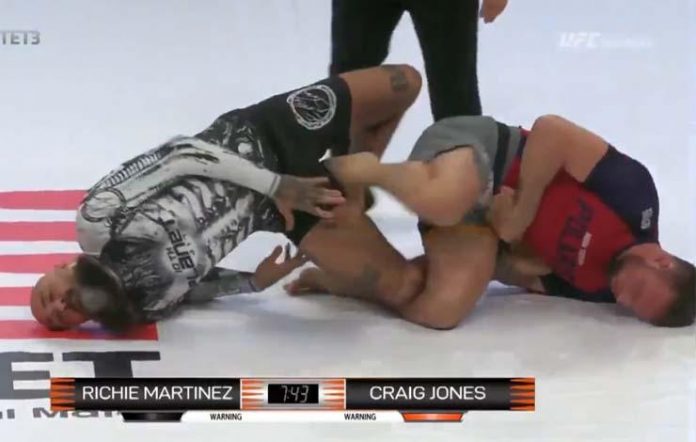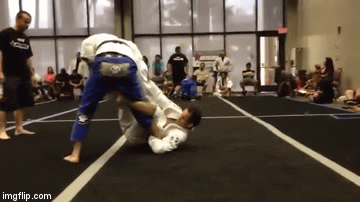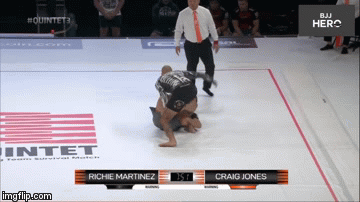
The De La Riva guard is a real staple of Jiu-Jitsu. It is not only a position that allows you to control and attack from the bottom but also an attractive form of open guard. All in all, it is one of the most utilized modern BJJ positions. In fact, it was a huge precursor for the emergence of the Berimbolo, the latest Jiu-Jitsu craze before leg locks. However, catching leg locks from the De la Riva Guard often proves to be a tricky business. Not many people have successfully applied a De La Riva Footlock in competition. There are, however, such options and they’re really high-percentage!
It is always great when you get a chance to connect some high-percentage move with a position you’ve been using for years. For people, that really love their Berimbolos, the modern leg lock game did not come as good news. The De La Riva guard opens leg attacks for the standing grappler. Moreover, there are a few legs locking counters to the Berimbolo to further frustrated players of this guard. Well, it is time for revenge! Now you can hunt for a De La Riva Footlock to completely catch opponent’ by surprise. It is a move that works, unlike many other previous foot lock attempts from the De la Riva.
The De La Riva Footlock
The De La Riva foot lock was somewhat of a Bigfoot for people that are enthusiast about both of those techniques. The basic principles of leg locking dictate that both our feet need to be between the opponent’s legs. Well, at least if the goal is an effective foot lock. The De La Riva guard which works with an outside hook seems directly opposed to this foundational principle. So, how does a leg lock from there actually work?
In essence, there are two ways in which you can use the De la Riva guard to get a foot lock. The most common one is to transition into a guard that provides you with an inside position for your legs. The usual contenders here are the single leg X guard (no surprise there) and the X-guard. While they both offer awesome leg locking options from the AShi Garam, they do require work to get into.
On the opposite side, you have a direct De la Riva foot lock setup. But how does it work? Doesn’t it go against the principle that guarantees leg lock success? Well, if you try it yourself, you’ll most likely end up frustrate d and give up. The trick here is to think outside the box. One world class grappler did and came up with a top option for a direct De La Riva foot lock. So much so, in fact, that this submission is often referred to as the Caio terra foot lock.
How It Works
The way these foot lock works is similar to a belly-down foot lock from the straight Ashi Garami. The lock is the same, but the positioning is completely different from what we’re used to. The Caio Terra De La Riva foot lock starts with a heel grip from the De La Riva. Even if you’re with the Gi, do not be tempted to hold on to the pants, but rather go for the heel.

The second step has to do with really sinking in the grip. With the Gi, you can use your own lapel to enforce the position of the hand. Moreover, you need to place the hook of your De La Riva leg inside the opponent’s hip, fingers pointing outwards. this gives you an anchor for hip control, as well as control over their knee. The opponent’s leg should be extended at this point.
For the finish, You need to turn towards the trapped leg, rolling over your shoulder. The foot lock is most powerful when finished from a belly down position. However, if you have everything set up correctly, you’ll rarely need to go all the way to the belly-down position. Can work as an ankle lock, finger lock or Achilles lock.
Troubleshooting
The main thing you need to focus on with the De La Riva foot lock is keeping the opponent’s leg as straight as possible while you set your grips up. In order to achieve this, you must maintain a distance. The best way to achieve this is to keep the pressure on their hips with your free leg. You can use foot to hip or hook the free leg of the opponent. Basically, anything will do as long as you can keep their hips away from yours so that you can work on the trapped leg.

Finally, do not forget your De La Riva hook. Your leg should not only dangle as you fight for grips and the hip distance. It is imperative that you keep your hook tight on the hips and use it to help you tilt to your side for the finish. The De La Riva hook actually acts as an Ashi Garami here, allowing you to completely control and move the leg of the opponent, from the hips down.
The Craig Jones Modification
OF course, some of the world’s top leg lockers have already tinkered with this effective De la Riva foot lock. One of them is Craig Jones, who seems to have decided that he needs more leg locking weapons in his arsenal. At the Quintet 3 tournament, Craig disposed of 10th Plante’s Richie “Boogeyman” Martinez.

It is also important to note that Craig had a really low grip. He had an arm around the foot of Martinez, so when he applied pressure the lock acted a lot like a heel hook on top of an ankle lock.
Check out all of Craig’s leg locking exploits in his “Down Under Leg Attacks” DVD instructional. In the 4 volumes of the instructional, he goes over a bunch of top and bottom leg lock setups, along with lots of signature moves. For anyone interested, there are also some cool leg lock defenses and counters ins there.
Final Thoughts
The De La Riva foot lock is a really potent weapon for many reasons. First, it is something very few people will expect from the position. Next, it is proven to work at the highest levels, bot hin GI and No-Gi. Finally, it is legal for everyone under any ruleset, as it is a straight foot lock. Even if you try to turn it into a heel hook, unless you do the Craig Jones grip you’ll fail due to the positioning. So use the foot lock as Caio or Craig and enjoy all the taps that you get from it!


![Darce Choke Encyclopedia – Origins, Mechanics and Variations [2025] BJJ, choke, Brabo, BJJ Darce Choke, D'arce Choke, Darce BJJ Choke](https://bjj-world.com/wp-content/uploads/2017/11/JungPoirierLeeYahoo-218x150.jpg)










![X-Guard Trickery Kyle Sleeman DVD Review [2025] X-Guard Trickery Kyle Sleeman DVD Review](https://bjj-world.com/wp-content/uploads/2025/03/x-guard-trickery-kyle-sleeman-dvd-review-218x150.png)
![Countering with Crab Ride Anthony Budion DVD Review [2025] Countering with Crab Ride Anthony Budion DVD Review](https://bjj-world.com/wp-content/uploads/2025/03/countering-with-crab-ride-anthony-budion-dvd-review-218x150.png)
![Closet Closed Guard Craig Jones DVD Review [2025] Closet Closed Guard Craig Jones DVD Review](https://bjj-world.com/wp-content/uploads/2025/03/closet-closed-guard-craig-jones-dvd-review-218x150.png)
![Xanadu Back Takes Levi Jones-Leary DVD Review [2025] Xanadu Back Takes Levi Jones-Leary DVD Review](https://bjj-world.com/wp-content/uploads/2025/03/xanadu-back-takes-levi-jones-leary-dvd-review-218x150.png)

![No-Gi Grapplers Guide To Front Headlock Joel Bane DVD Review [2025] No-Gi Grapplers Guide To Front Headlock Joel Bane DVD Review](https://bjj-world.com/wp-content/uploads/2025/03/no-gi-front-headlock-joel-bane-dvd-review-218x150.png)
![No-Gi Defense Xande Ribeiro DVD Review [2024] No-Gi Defense Xande Ribeiro DVD Review](https://bjj-world.com/wp-content/uploads/2024/11/no-gi-defense-xande-ribeiro-dvd-review-324x235.png)
![Essential Shin To Shin System Shawn Williams DVD Review [2025] Essential Shin To Shin System Shawn Williams DVD Review](https://bjj-world.com/wp-content/uploads/2025/01/shin-to-shin-system-shawn-williams-dvd-review-100x70.png)

![Osoto Gari for Jiu Jitsu Jackson Nagai DVD Review [2024] Osoto Gari for Jiu Jitsu Jackson Nagai DVD Review](https://bjj-world.com/wp-content/uploads/2024/10/osoto-gari-for-jiu-jitsu-jackson-nagai-dvd-review-100x70.png)
![Complete Front Headlock System Michael Pixley DVD Review [2024] Complete Front Headlock System Michael Pixley DVD Review](https://bjj-world.com/wp-content/uploads/2024/10/front-headlock-system-michael-pixley-dvd-review-100x70.png)

![The Closed Guard Malachy Friedman BJJ DVD Review [2025] The Closed Guard Malachy Friedman BJJ DVD Review](https://bjj-world.com/wp-content/uploads/2025/01/closed-guard-malachy-friedman-bjj-dvd-review-100x70.png)
![Higher Tripod Passing Craig Jones DVD Review [2025] Higher Tripod Passing Craig Jones DVD Review](https://bjj-world.com/wp-content/uploads/2025/02/higher-tripod-passing-craig-jones-dvd-review-100x70.png)


![Two Sides One Game Sweep and Pass Marcos Tinoco DVD Review [2024] Two Sides One Game Sweep and Pass Marcos Tinoco DVD Review](https://bjj-world.com/wp-content/uploads/2024/11/sweep-and-pass-marcos-tinoco-dvd-review-100x70.png)
![Compass Kneebar System Charles Harriott DVD Review [2024] Compass Kneebar System Charles Harriott DVD Review](https://bjj-world.com/wp-content/uploads/2024/11/compass-kneebar-system-charles-harriott-dvd-review-100x70.png)
![Feet Finder Foot Sweeps Christian Ozbek DVD Review [2024] Feet Finder Foot Sweeps Christian Ozbek DVD Review](https://bjj-world.com/wp-content/uploads/2024/09/feet-finder-foot-sweeps-christian-ozbek-dvd-review-100x70.png)


![X-Guard Trickery Kyle Sleeman DVD Review [2025] X-Guard Trickery Kyle Sleeman DVD Review](https://bjj-world.com/wp-content/uploads/2025/03/x-guard-trickery-kyle-sleeman-dvd-review-100x70.png)




![Spider and Lasso Guard Jared Welman DVD Review [2025] Spider and Lasso Guard Jared Welman DVD Review](https://bjj-world.com/wp-content/uploads/2025/01/spider-and-lasso-guard-jared-welman-dvd-review-100x70.png)


![Special K Guard Neil Melanson DVD Review [2025] Special K Guard Neil Melanson DVD Review](https://bjj-world.com/wp-content/uploads/2025/03/special-k-guard-neil-melanson-dvd-review-100x70.png)
![Wristlocks From The Top Pete Letsos DVD Review [2025] Wristlocks From The Top Pete Letsos DVD Review](https://bjj-world.com/wp-content/uploads/2025/01/wristlocks-from-the-top-pete-letsos-dvd-review-100x70.png)

![Bricks Kesa Gatame System Jeremy Brick DVD Review [2025] Bricks Kesa Gatame System Jeremy Brick DVD Review](https://bjj-world.com/wp-content/uploads/2025/02/bricks-kesa-gatame-system-jeremy-brick-dvd-review-100x70.png)
![Mastering The Crucifix Alexandre Pereira DVD Review [2025] Mastering The Crucifix Alexandre Pereira DVD Review](https://bjj-world.com/wp-content/uploads/2025/01/mastering-the-crucifix-alexandre-pereira-dvd-review-100x70.png)
![Jeff Glover DVD Bundle Review: Chokin’ Around With Uncle Jeff [2024] Jeff Glover DVD Bundle Review: Chokin' Around With Uncle Jeff](https://bjj-world.com/wp-content/uploads/2024/10/jeff-glover-dvd-bundle-review-chokin-around-100x70.png)